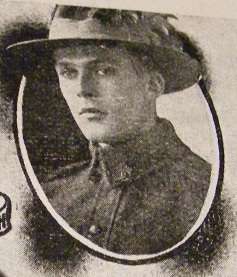
S8391
MURRAY, Bill
| Service Number: | 2357 |
|---|---|
| Enlisted: | Not yet discovered |
| Last Rank: | Private |
| Last Unit: | 9th Light Horse Regiment |
| Born: | Not yet discovered |
| Home Town: | Not yet discovered |
| Schooling: | Not yet discovered |
| Occupation: | Architect |
| Died: | Circumstances of death not yet discovered |
| Cemetery: |
Centennial Park Cemetery, South Australia |
| Memorials: |
World War 1 Service
| 28 Apr 1916: | Involvement Private, 2357, 9th Light Horse Regiment, --- :embarkation_roll: roll_number: '2' embarkation_place: Adelaide embarkation_ship: HMAT Bakara embarkation_ship_number: A41 public_note: '' | |
|---|---|---|
| 28 Apr 1916: | Embarked Private, 2357, 9th Light Horse Regiment, HMAT Bakara, Adelaide |
Bill Murray
Name: Bill Hope Murray
Service Number: 2357
Place of Birth: Woodside
Date of Birth: 8 January 1897
Place of Enlistment: Adelaide
Date of Enlistment: Not available
Age at Enlistment: 19 years
Next of Kin: Mother, Mrs. Florence Edith Murray / St. Peters
Occupation: Architect and Farmer
Religion: Presbyterian
Rank: Private
Bill grew up on the Mt. Beevor property east of Woodside/Harrogate currently owned by J.F. Downer. He worked as a trainee draftsman upon completing his schooling. Bill’s father, Tom, took his brother William with him to see his newly-born son. William named him after himself and dropped the family name of Hope without the knowledge or consent of Tom’s wife Florence. Consequently, instead of being listed on Army records as Bill Murray, he should be listed as Bill Hope Murray as he resumed using the full family name after returning from the First World War.
Bill had a brother Ken who was 3 years older. Ken left home and went to Scotland where he enlisted in World War One, joining the Scottish Highlanders. He died of wounds at the age of 22 and was buried near Arras in France. Because of this Bill’s mother would not allow him to enlist until he was 19.
Shortly after enlisting Bill left Adelaide on board HMAT A41 Bakara on 28 April 1916. He was hospitalised with mumps on 30 November. In September 1917 he was transferred to Port Said in Egypt. Mumps, asthma and debility due to his time spent serving in Palestine resulted in several periods of hospitalisation during Bill’s period of service.
While overseas Bill regularly wrote home to his mother and his sister Nancy, who was the youngest in the family. In December 1916 he wrote to Nancy from Egypt, asking how the home garden was faring. In his letter to his mother from Syria in April 1917 he stressed he was in good health and thanked her for the tobacco and cigarettes she had sent. In January 1918 he wrote to her stating the Light Horse couldn’t leave their horses with the Arabs as they were cruel to them through overloading them and feeding them poorly. Bill’s other letters home described the beauty of Tripoli and major towns, a visit to a bazaar and appreciation of gifts sent including a shirt and scarf. Only once did he mention sadness over the death of a comrade- that of his cousin Doug due to dysentery.
Trooper Murray returned to Australia on the Oxfordshire on 10 August 1919 and was discharged on 25 September.
Bill worked for two architects, Danker and later Jackman upon his return home. He declined an offer from his uncles to help him to settle on the land. Bill also chose to reject the offer from his second cousin Sir George Murray, the Chief Justice and later Deputy-Governor to go into Chambers and establish a career in Law.
After the war Bill, as an architect worked on several local buildings including the Hahndorf and Woodside Institutes. He also did the architectural work on the Alice Springs Post Office. When the depression of 1929 came Bill could not get any work as an architect as very little construction work was being undertaken. He bought a property on Beaumont Road at Verdun and raised chickens so as to get by during the economic crisis. Bill stayed on the property until 1963 when he moved to Myrtle Bank in Adelaide.
Colin Hope Murray, Bill’s son remembers his father suffering severe sinus problems largely due to serving with the Light Horse in Palestine. He said his father never spoke of his wartime experiences. Bill was an active member of the Woodside R.S.L. and attended several Anzac Day services. During World War Two he was a member of the Volunteer Detachment Corps {VDC}, in which he served as a Sergeant.
Bill Hope Murray died on 3 December 1987 aged 90. He was cremated at a private service and his ashes were scattered at Mt. Crawford Cemetery. His wife Joyce died at the age of 98.
*Information kindly provided by Colin Hope Murray at an interview conducted on 11 January 2012.
Submitted 26 October 2023 by christopher collins









